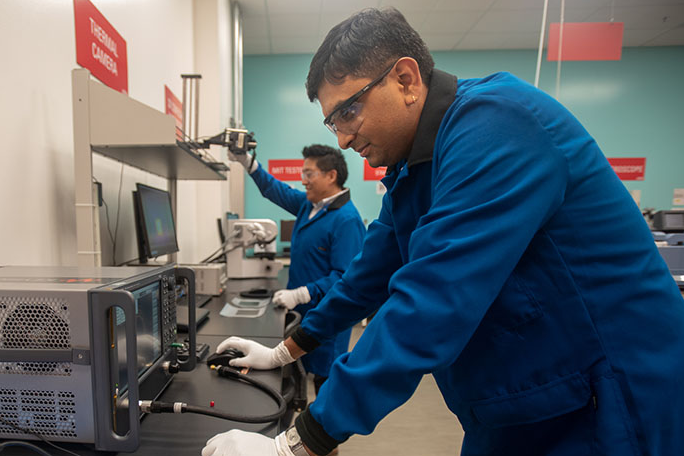Illinois-based 3D printer manufacturer Azul 3D has partnered with electronics firm DuPont, to introduce “next-generation 3D printing technologies” into the electronic materials industry.
The exclusive development agreement will see Azul 3D use its High-Area Rapid Printing (HARP) technology to expand the adoption of 3D printing into “previously inaccessible” applications. According to Chad Mirkin, Co-founder and Chair of Azul 3D, the companies’ partnership could allow its HARP rapid manufacturing technique to fulfill its end-use potential.
“This collaboration with DuPont is very important to us,” said Mirkin. “In addition to validating the industry-enabling capabilities of HARP, it showcases our ability to use it to transform aspects of the manufacturing sector.”
HARP 3D printing technology
Azul 3D was founded in 2016 by Chad A. Mirkin, David Walker and James Hedrick, the researchers who developed the HARP 3D printing process at Northwestern University. Having initially operated in stealth mode for three years, the firm has now spun off from the university, and is attempting to commercialize the technology.
HARP was first detailed in a study within the journal of science in 2019, in which the researchers claimed that their custom-made system could achieve a record-breaking level of throughput. According to the team, their machine was capable of printing objects up to 13-feet (3962 mm) tall, making it “vastly larger than current printers,” and at speeds of half a yard (457.2 mm) an hour.
The company now markets its 3D printer as an alternative to stereolithography (SLA)-based systems that are either limited by their print speed or the size of their build volume. Mirkin led HARP’s initial product development, and believes that the technology could help to overcome long-standing limitations within the industry.
“When you can print fast and large, it can really change the way we think about manufacturing,” explained Mirkin. “With HARP, you can build anything you want without molds and without a warehouse full of parts. You can print anything you can imagine on-demand.”
Azul’s HARP technology is able to provide users with faster and larger prints due to its use of a nonstick liquid called fluorinated oil, which removes heat, and prevents adhesion to the print bed. As a result, HARP-processed parts can be produced at an accelerated pace, and don’t feature the cracking that sometimes affects larger SLA 3D printed objects.

Additional financing and Azul’s partnership
Since going public with its proprietary 3D printing process, Azul 3D has gone on to raise over $12.5 million worth of investment to put towards its development. In the firm’s second and largest round of seed funding, the investors themselves weren’t revealed, but the company did state that it expected to ship its first HARP 3D printers to beta partners in Q1 2021.
Azul 3D said at the time that its new systems would be focused on mass manufacturing rather than prototyping applications, and that they could be capable of printing several tons of polymer products each year. Although it’s not clear whether its launch schedule for the machines will be disrupted by the ongoing pandemic, the company has continued to seek new applications for its HARP systems elsewhere.
Through its new partnership with DuPont, Azul 3D will now attempt to leverage the innate advantages of its proprietary process, to develop enhanced products for DuPont’s clients in the electronics and imaging sector.
“Combining DuPont’s expertise with Azul 3D’s capabilities in 3D printing will be a powerful pathway for exploring new technology innovations,” said Nick Pugliano, Business Development Director of DuPont Electronics & Imaging. “We’re looking forward to collaborating to meet emerging industry needs.”
“We’re excited to get to work with DuPont’s visionary team and to move the field forward,” added David Walker, Co-founder and CTO of Azul 3D. “This is a great example of how HARP isn’t just competing with other technologies in niche applications, we’re fundamentally expanding the adoption of additive manufacturing into exciting and previously inaccessible applications.”
Recent advances in large-format 3D printing
Azul 3D is not the first company to launch a large-format resin-based 3D printer, and machines are increasingly being designed with more sizable print volumes to cater for a wider audience.
Formlabs has recently released its 3L and announced its 3BL line of printers, which feature a build volume of 335 x 200 x 300mm, and are primarily aimed at dental and design professionals. The company recently claimed that the increased size of the 3L’s print bed would enable it to address 90 percent of the available market.
Similarly, UK-based industrial 3D printing specialist RPS launched its NEO800 3D printer in November 2018. The resin-based machine can hold 630kg of feedstock, and has a substantial build volume of 800 x 800 x 600mm.
Photocentric, on the other hand, offers its LC Magna system, a large-format LCD-based SLA 3D printer, with a print volume of 510mm x 280mm x 350mm. The company’s daylight photopolymerization process cures resin at wavelengths larger than 405 nm, making it safer to work around, and considerably cheaper than using UV energy sources.
Nominations for the 2020 3D Printing Industry Awards are still open, let us know who is leading the industry now.
The fourth edition of the 3D Printing Industry Awards Trophy Design Competition is now underway. Enter your design for the chance to win a CraftBot Flow 3D printer.
To stay up to date with the latest 3D printing news, don’t forget to subscribe to the 3D Printing Industry newsletter or follow us on Twitter or liking our page on Facebook.
Are you looking for a job in the additive manufacturing industry? Visit 3D Printing Jobs for a selection of roles in the industry.
Featured image shows a DuPont engineer working on an electronics product. Photo via DuPont.



